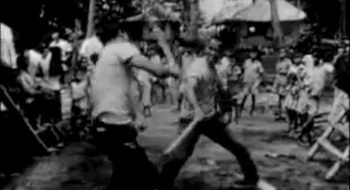The first and most important concept of defense in Filipino stick fighting is to hit the weapon hand of the opponent for if he can’t wield a weapon, he is harmless regardless of his size and strength.
This is akin to taking off the fangs of a snake to render it harmless hence this concept is popularly known as “defanging the snake” among Filipino martial arts (FMA) practitioners. Filipino stick fighters knew that the best disarm is always a direct hit to the weapon hand; the best defense is a good offense they say. This concept is applicable to combat with bladed weapons and empty hands not just stick fighting.
But just like any ideal technique, directly hitting an opponent’s weapon hand is not always possible. In western fencing this is the equivalent of a simple attack. The term “simple” is actually a misnomer because any expert fencer knew that it is hardest to score a point with a simple attack.
In general, Filipino stick fighting can be played long range (largo) or close range (corto). In some traditional FMA styles in Luzon, long range fighting is referred to as “kabaroan” or new long range style and close range fighting as “kadaanan” or old close range style. The range would dictate the nature of defense that a fighter would use.
Long range defense
Those who prefer to fight within the largo range put a premium on direct hitting as primary method of defense. Cultivating keen spatial judgement, long range stick fighters are adept in delivering strikes from a position of relative safety.
The simple goal is to hit any bodily target within range without getting hit yourself. Given a choice, these fighters would exploit to the hilt the protection offered by distance and the maximum reach of their weapons.
Besides spatial judgement, the other desirable attributes to cultivate for long range stick fighting are speed, precision, fast reaction time and footwork.
Characteristically, long range stick fighters avoid stick-to-stick contact during a skirmish and attempts to hit the opponent’s weapon hand instead. They would use footwork and evasive body movements to avoid blows instead of blocking as much as possible.
It would also be noticeable that because of the distance, there is very little opportunity to use the “alive” hand or the non-weapon hand for checking, disarms and other defensive maneuvers.
Close range defense
Close range stick fighters on the other hand would almost always tie up their opponents. Close range stick fighting while not necessarily more effective is harder to master because it requires a high degree of kinaesthetic sensitivity or in simpler terms the ability to detect pressure or lack of pressure as the practitioner engage his opponent in close range.
In such a setting, the weapon hand, the alive hand and footwork simultaneously come into play to defend and to penetrate an enemy’s defense. Besides the aforementioned, the use of the punyo (Spanish word for “fist”) or the butt of the stick is extensive at close range. The punyo is a vicious close quarter tool that can be use to butt, scrape and hook an opponent.
Fighting at close range requires the ability to manipulate the opponent’s body into disadvantageous positions hence stick fighters who prefer this range possesses diverse skills in trapping, joint locking, disarms and other close quarter combat skills.
In long range stick fighting, a precise blow usually ends the altercation but in close range stick fighting this may not necessarily be the case as a joint lock or strangulation could also terminate a fight.
Passive block and purposeful block
Given the aggressive nature of the FMA, many practitioners consider blocking stick-to-stick as a passive and unproductive move. But blocking happens in stick fighting regardless of style and range. As previously stated, it is a good goal to always hit the opponent’s weapon hand when defending but then again this is not always possible.
Advance practitioners of stick fighting are adept on how to make a block purposeful instead of passive. A block is no longer passive if it became a part of an elaborate strategy to lure an opponent to make an opening.
A good example is defending against an overhead strike with a roof block. If the objective in executing a roof block is to slide the opponent’s stick to the side so you can strike his head, the block is purposeful not passive.
It is a passive block though when delivered with no other purpose in mind but just to block.
A skilful stick fighter can also use the force of the block as a springboard to launch an attack on another movement plane. A force is generated when sticks collide and some skilful fighters would use one or two passes in the form of blocks to generate a devastating power strike.
Therefore, an arnisador countering with a series of block may not really be in the defensive but in actuality setting up for the kill.





















